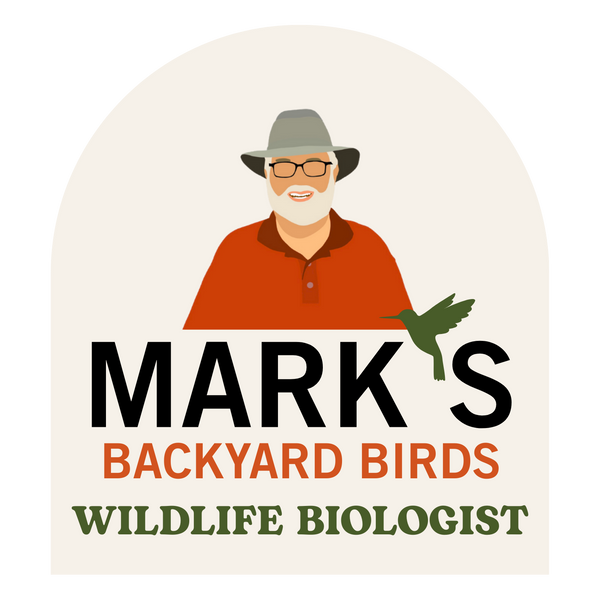Ask Mark
Here are some Frequently Asked Questions (FAQs) that may help answer some of your curiosities!
If you have any further questions or want to know more, please contact us!
6212 NW Barry Road
Kansas City, Mo 64154
(816) 746-1113Top Questions
Should I stop feeding birds with warmer weather?
That is really up to you. Most of my customers do cut back on feeding during July, August & September. There are birds around and they will visit your feeders year round but due to territoriality, birds like cardinal & chickadees will not tolerate rivals within their boundaries which may include your feeders. My favorite part of summer feeding is watching the adults bringing in their young and passing seeds to them. If you want or need to cut back, a typical scenario is to cut back on your ground and large feeders but continue with your finch and peanut feeders. Remember goldfinches typically do not nest until July so you will have large flocks at your feeders through mid July.
I have the worst problems with common grackles this summer. What Can I do?
This has been a terrible season for grackles. Unfortunately, grackles are very agile and much smaller than squirrels. We have found that most counter-weight feeders are not effective against avian pests like grackles and starlings. The best ways that I know to truly keep these pests at bay is to feed straight safflower in feeders they can land on and a good cage feeder for anything with sunflower or peanuts in it. Not all cage feeders will do the trick. The cage needs to be far enough away from the food so these birds can’t reach it with their necks stretched.
Are bird bath heaters costly or dangerous?
No, definitely not. Realize that a bird bath heater’s job is to keep water unfrozen, which means 33 degrees or so—they don’t create a Jacuzzi for the birds. Bird Bath Heaters draw very little energy and most are equipped with a thermostat to turn off when the temperature is above 34. The best safety tip I can give you is to wrap the connection to the extension cord with electrical tape and you should get a good moisture seal.
How do I keep birds from building nests on my porch light
Each spring we deal with the issue of birds building nest were they are just not wanted. Two things to remember; once birds have laid their eggs, you can’t touch their nest (except European Starlings and House Sparrows) and birds are best discouraged with visual deterrents. While not guaranteed, a toy snake draped across or tacked up close to the area where they are trying to build is enough to get them to abandon that nest site. We also have Scare Tape that can be suspended in the area and some have had luck with hanging old CDs from the ceiling or covering a common area with aluminum foil. They will find a new place to nest.
How do I keep deer out of my feeder?
In a word, height. Because deer can reach about six feet up when they want to, you need to get the bottom of your feeders at least six feet up in the air. If you are feeding from a deck arm that usually isn't a problem, but from a pole system or tree limb it can be hard to reach your feeders. As usual, we have items that can help. Erva Pole extensions of up to 28" can get your feeders high enough in the air and their SkyHook fit into a piece of PVC or hollow pipe to help you lift your feeder on and off the higher hooks.
When will my hummingbirds be leaving? Should I take my feeder down to make them leave?
Hummingbirds like other birds are triggered by day length to start their migrations. Because flying is so costly on a bird’s body, they have to fatten up to survive their nightly flights (one reason they defend feeders so vigorously this time of year).By keeping your feeders out and filled late into the fall, you may help a late migrating bird that is coming through when natural food is truly scarce. In the past few years, we have consistently gotten reports of hummingbirds at feeders through the first week of October.
Does Hummingbird nectar need to be red?
Some are convinced that if they do not put the red food coloring in their feeders, they will lose their hummingbirds. The truth is, hummers don’t know the color of the nectar. They key in on the feeder. More specifically, they key in on the “flower” openings, stick the tip of their bill in and lap the nectar like a dog. They don’t look into the holes to check the color. Clear nectar is fine.
Does the hummingbird feeder have to be red to attract them?
Definitely not. While red is the classic color for attracting them, I have seen hummers feeding on practically every color there is. In early spring, they love buckeyes, which are yellow. I recently planted some May Night Salvia (purple) and had a male feeding on them within 10 minutes of getting them in the ground. All color hummingbird feeders are great.
What is the secret to keeping squirrels and racoons out of my suet?
Luckily, squirrels don’t tend to take to suet as often as they do sunflower but we do get the occasional report. The real problem tends to be with the “night shift”. Many people simply take their suet feeders in at night. While this very effective, it only takes forgetting it once that leads to a trip down to the edge of the woods to retrieve the feeder. The simplest solution that I have found is Hot Pepper Suet. No, it doesn’t hurt the birds and they will eat it just as well as many of the other formulas. Mammals have very different taste systems from birds and are quite sensitive to the peppers. They will leave it alone. Some do like to rotate the Hot Pepper with their favorite cake. If you do want to do this, remember to wear cloves while handling the pepper cakes.
What is the proper ratio for hummingbird nectar?
Another of our more common spring questions, the ration is 4 parts water to 1 part sugar. There are many people out there that will use 3 to 1 and even 2 to 1. According to the North American Hummingbird Society who has sponsored numerous studies on the topic, 4 to 1 is the best ratio for the birds. The issue in most cases is water. The stronger the sugar mix, the more water the hummingbirds have to take in to break it down. This means more time traveling to and from dependable water sources and wasted energy for the birds.
Should I pick up a baby bird?
This depends. If you are picking the bird up to place it back into a nest or putting it up on a limb so that a dog or cat can’t get to it - YES. Birds have terrible senses of smell and do not care about human scent. If you are picking it up to take it to somewhere else, the answer is NO. Most baby birds that are on the ground are very close to being on their own and they generally need only a few more bugs or worms from the adults to make it. Too often people pick them up and take them to a vet or nature center while mom and dad birds are going nuts looking for their baby. Let nature take its course.
Why is the cardinal/bluebird/robin banging repeatedly against my windows?
I know this is not new for many of you, but it is easily the most frequently asked question each spring. It is also the same reason the woodpeckers drum on your downspouts and/or flashing around your fireplace. Plain and simple it is “love”. The birds banging into your window repeatedly are seeing their reflection and think it is an intruder in their territory. He or she is doing its best to run this freeloader off. The only guaranteed solution is to cover the window on the outside for the next few weeks (nesting season).
When should I have my boxes for bluebirds up?
Last year was an incredible year for early bluebirds. Typically they do not start nesting until April, sometimes late April. Will we see eggs again in March like some landlords did? I recommend each year to have your boxes up and cleaned by late February no matter the weather. Bluebirds will start their pair bonding then and start checking out potential nesting sights. We often see them taking a few sprigs of grass into the box that gets us really excited but it is much too early for them to be laying eggs now. Be patient and remember they generally nest 3 times per season.
Does anything eat Safflower?
I still chuckle when people say “nothing eats that stuff”. If that is the case, it is disappearing by the thousands of pounds each year from feeders in our area because it is only second in sales to Black Oil Sunflower. It is true that less birds like Safflower, but this is considered a good things by most. It is the less desirable birds like House Sparrows, Common Grackle and Brown-headed Cowbirds that tend not to like it (not to mention squirrels). The good news is we have been experimenting with a new Safflower seed know as NutraSaff, that is both more nutritionally valuable and accepted by more birds. At my house I have seen many species of birds including American Goldfinches eating it, something I never witnessed with regular Safflower. My squirrels still hate it.
The basic seeds like Sunflower and Safflower are the simplest way to feed birds and some customers like to create their own custom blends by mixing the basic seeds in their own preferred ratios.
What is the best method for cleaning my birdfeeder?
That is a very timely topic. Many people like to clean their feeders up at the end of the hot summer season in preparation for the “official” feeding season. First I make sure the feeders are empty, then soak them in plain water for about 30 minutes. I then wash them in a liquid detergent (Dawn). I have a couple of different brushes I use and depending on the degree of “filth”, I may take the feeder completely apart for this. After thoroughly rinsing all the parts, I spray my feeders down with a 10% bleach solution to kill any bacteria that may have survived the cleaning.
Are there fewer hummingbirds this year? (Fall 2014)
It is amazing how this question gets asked each year. Two customers will come in bragging about how many hummingbirds they have and the next will want to know if the population has crashed because they are not seeing any. It is hard to know and the people who are not seeing them are rarely comforted by any answer I give them. As with the question above, I really think that hummingbirds have done quite well this summer but I think that the wet conditions have led to bountiful wildflowers and landscaping. Hummingbirds just don’t need the hummingbird feeders as much in years such as this so numbers may appear to be down when they are actually higher than normal
Attracting Birds
I had bluebirds at my birdbath this winter. Will they stay and nest?
We know from banding data that many of the bluebirds we have here in winter are actually northern birds who have moved down to more inhabitable areas. So the answer is not necessarily. The key to attracting nesting bluebirds is habitat and a well-placed box. While bluebirds may seek food in wooded areas in winter, they prefer open areas with scattered trees for nesting. You may see them visit a nest box as early as mid February but they will not get serious about nesting in our area until the first week or so of April.
When is it safe to clean out my bird houses for the season?
Many birds only nest once each summer but most of our residents attempt multiple nestlings. It is always a good idea to clean out bluebird and wren houses after each nesting if you houses are designed to do this easily. Once young birds leave their nest, they do not return. Cleaning out the nest is a good way to prevent passing one set of problems along to new residents. Bluebirds will not use the same nesting materials and will simply build a new nest on top of the old. If the old nest had an issue with lice or mites, those problems will make it hard on the new hatchlings. The exact date for fall cleaning is tough. Since many species will attempt a nest very late in the season if conditions are favorable, I would put off your “winterizing” until October or so if you can.
Last August I thought I had a Rufous Hummingbird at my feeder. Could it have been one?
Yes. Though rare, we know that a small population of rufous hummingbirds over winter in Florida. Many of those birds pass through our area each fall. One of my customers gave me a great description of an adult male rufous that visited his feeder for a day late last August. Keep your eyes open, take notes if you see something different and don’t hesitate to call me.
Should I try to run off the sparrows form my feeders?
Well . . ., you may have heard me rant a little about the House Sparrows at my feeders and my desire to thin them out a little. Keep in mind I am talking about the non-native House or English Sparrow that crowd out our native birds. To learn more about the many wonderful native sparrows that can be attracted to your feeder station ask for a copy of Winter Sparrows, a reprint of an article I wrote for the Missouri Conservation magazine several years ago.
Why can’t I get anything to use my birdbath?
There are generally two major issues that plague birdbaths. First is their distance from cover. Just as with feeders, a birdbath that is too far from escape cover will make birds feel vulnerable. By far, the most common problem is that the birdbath in question is too deep. Birds need shallow water and most “bowls” don’t have shallow areas. We recommend placing rocks in a bath to give different depths of water but now we have a new option. The Bird Raft ™ is designed to fit in water features to create a shallow bird bath that can change with the feature’s depth.
Has everyone been seeing lots of different birds at their oriole feeders this year? (SPRING 2008)
Definitely. We have had loads of reports this spring of “never seen before” birds feeding on oranges and especially jelly. Aside from the Baltimore and Orchard Orioles, we have had the semi-regular Grey Catbirds, Downy and Red-bellied Woodpeckers, House Finches, Northern Cardinals, Cedar Waxwings, and Northern Mockingbirds. We’ve had reports of American Goldfinch, Scarlet Tanagers, Summer Tanager, Western Tanager (very rare in MO) and Tennessee Warblers feeding as well. Call or e-mail us if you have any species that we can add to the list.
Is there anything I can place out that will help the hummingbirds with their nesting?
Hummingbirds build their nest primarily from spider webs, moss and plant down. Songbird Station now has a new nesting helper that contains materials they can use as nest liner.
Where did my goldfinches go this spring? (SPRING 2008)
Goldfinches are resident birds that come and go from feeders primarily with wild food availability. In the early spring, one of the first wild seeds available are the dandelions. Soon to follow are the oaks, maples and other trees. Last year most of that food crop was killed by the “Easter Freeze” so goldfinches were plentiful at the feeders’ right through spring. Don’t fear, they will be back on and off through till July when they start nesting.
I just love the little White-throated Sparrows and Juncos. What do they like to eat?
These two native sparrows are among the easiest birds to keep happy. They love white proso millet spread on a flat surface. A nice tray feeder low to the ground helps keep the seed dry but the sparrows are perfectly happy eating right off of the ground. See also new Ground Throw Mix.
Where have all of my woodpeckers gone? (FALL 2008)
As I almost always do with this kind of question, I look to what kind of summer we have had and what the natural food supply is like going into winter. The cool, wet summer has really produced a bountiful natural food supply and birds are reacting to that. Many woodpeckers, especially Red-headed's are driven by acorn supplies and will sometimes concentrate in areas where they are heavy. Rest assured that when times get tougher (low temperatures, ice, snow) they will be at your feeders just as often as any year.
My dad is convinced the cheap bag of bird seed he gets at the grocery store is perfectly fine for his birds. He is on a limited budget, what can I tell him? (FALL 2009)
Plain and simple, it really is expectations. The “cheap” birdseed blends are filled with fillers like milo, cracked corn, wheat, sticks, stems, rocks and who knows what else. If he is OK with feeding hordes of House Sparrows, grackle and Mourning Doves then the cheap mixes are probably fine. If he wants to attract cardinals, chickadees, flickers and other beautiful birds then he will do far better with quality seed. I can’t imagine a bag of the “cheep” seed costing much less than a 50lb bag of Black Oil Sunflower (the favorite seed of more birds than any other). If he does want to feed the sparrows and doves, he is better just buying a bag of White Proso Millet and spreading in on the ground and leaving the feeders for the sunflower and better birds. The proof is in the results. Give this a try and see what happens.
Can I use an extension cord with my bird bath deicer?
Yes. I have been using an extension cord (generally a 50 ft. one) with my deicers for 15 years and have never had a problem with them. I do have to get a little creative with my lawn chair placement to keep my chew happy Black Lab from getting to it. The most important safety precaution is to make sure it is plugged into a groundfault outlet.
I read that you should save up your dryer lint and put it out for the birds for nesting material.
No. Do not place dryer lint out for the birds. I know that several publications a few years ago put this out as a way to help birds and Ornithologist have been trying to undo this damage ever since. The fear is that the small dust that is present in lint will be dangerous for the hatchling’s lungs. We have many good alternatives here at the store. Nesting material wreaths, bells and cages can be filled over and over again with various refill packs that contain a mixture of strings, feathers, cotton, etc.
Why can’t I get the hummingbirds I see in the spring to stick around for the summer?
In the spring it is all about set up territories and finding a suitable place for a nest. If you have birds at your feeders in the spring but not during the early summer it usually means the females didn’t find the nesting conditions she wanted in your “yard”. Don’t feel bad, most of us do not have nesting hummers. The good news is the easiest time to attract them to your yard in the late summer. The more dedicated you are to your flowers and landscaping in the spring will pay dividends later.
I keep seeing commercials for a bird seed that is supposed to attract pretty birds. Is theirs any different than your blend?
Other than being twice as expensive as our house blend, there is very little difference. I always say that a sunflower is a sunflower no matter what color the bag is. A customer brought in one of these expensive bags of seed recently and here is what I found. They include four seeds that I would never use in my premium general seeds (white millet, red millet and canary seed and nyjer). I do use millet in my ground mixes to take care of the sparrows, dove and blackbirds. Canary seed, I do not use at all and nyjer is a finch seed that should be limited to use in finch feeders. Trying to put too many kinds of seed in the same bag, more often than not, leads to problems with less desirable birds.
Is it true that feeding the raccoon and deer is a bad idea?
It is definitely true. The Missouri Department of Conservation recommends that you do not intentionally feed critters such as raccoon and deer. There are many reasons but the picture here should illustrate the point well. One little masked bandit is cute but 17 are nothing but trouble. What do they do when the free food runs out? Trash cans, dog bowls, grill covers, anything that smell remotely like food is fair game. On top of all that, don’t forget that raccoons can carry rabies and distemper. Raccoon baffles from ERVA are super effective at keeping these rascals from climbing your feeder poles
How do I keep the mosquitoes from laying eggs in my water feature?
The keys to keeping mosquitos from using your water features as a breeding ground is moving water. Our best selling device is the Water Wiggler. It is very simple and works great in most bird baths. Two D cell batteries make two “aggitators” run for weeks. The water surface constantly ripples so mosquito eggs will fall to the bottom of the bird bath.
When will the grackle be leaving?
People who are overrun by grackle can’t wait till they leave. Typically, they leave the feeders in August and move out into the farm country. They will head to the southern states in September/October. Until then, use Safflower, Nyjer and cage feeders to keep them in check.
Where do the yellow finches go in the fall?
American Goldfinches never leave our area. In the late summer early fall season, they primarily retreat to weedy fields to feast on Mother’s Nature’s bounty. Seeds from many weeds such as Giant Ragweed are just too plentiful to resist. By late November, those seeds are starting to drop to the ground and become harder to find, thus the return of the finches (in their winter plumage) to our feeders. Our number of our goldfinches can grow heavily in the winter as birds from Iowa, Minnesota and points even further north come here to overwinter.
Do birds really need bird seed now? (SPRING 2012)
If you think about what is happening in the plant world during the spring, you quickly realize this is probably the most important time to provide seed for birds. The natural seeds and berries that birds have been feeding on all winter are gone and freshly growing plants will not be producing any seed for quite a while. When you factor in the number of returning species like Rose-breasted Grosbeaks and Indigo Buntings, there is a good reason to feed birds for them and for us.
Can I use raw (turbinado) sugar for my hummingbird nectar?
According to hummingbird “experts” , it is not good to use raw sugar. I understand this is a growing trend among many for human consumption but the fear is that there are more impurities in the raw sugar that could be harmful to the hummingbirds.
I have so many trees in my yard that baffles really don’t help against the squirrels. What can I do?
First, I am jealous of all the trees. You have great habitat for the birds and shouldn’t have to worry about furry creatures. One of the best performing products we have gotten in lately is Flaming Squirrel from Cole’s. Nothing is 100% effective for everybody, but this product has received extremely high reviews from our customers. It is a habenero oil that you mix in with your seed. Birds are not affected but most mammals can’t take the heat.
The Squirrels keep chewing the hole of my nest boxes so they can get their heads in. What can I do?
This is actually a very common problem and a simple fix. We have portal protectors from 3 different companies in stock. They come in 3 different sizes and easily drill into your box. If the hole is too big now, it is best to cut a new square of wood that will fit over the old hole, drill a new hole and attach the protecter to the new piece of wood.
Spring rains can cause my seed to get “mushy”. Should I throw it out when this happens.
The short answer is Yes. Wet seed leads to mold and promotes bacteria growth. The exception to the rule is if the seed is in a feeder that provides good protection and rain is followed by good sunlight and wind, the seed can dry quickly and your fine. If it is an extended period of rain and grey, overcast conditions, the seed will need to be thrown out. Adding a good hood to feeders that have hulless seed is especially helpful.
When do the blackbirds return to the area?
This is one of our signs of spring that we do not look forward to each year. In most years we start to see Brown-headed Cowbirds, Common Grackle and Red-winged Blackbirds showing up at feeders as early as late February. Last winter it was so cold and snowy during that time so they didn’t return in good numbers until late March. Many switch to Safflower in their open trays as the blackbird group really don’t like it. Caged feeders work extremely well against grackle for sunflower or peanuts.
Do spiderwebs really pose a threat to hummingbirds?
Last summer, my nephew in North Carolina found this female Ruby-throated Hummingbird that had gotten tangled up in a web quite severely. Luckily he was able to get her cleaned up and on her way again.
How do I keep seeds from sprouting under my feeders?
The only real way is to feed hulless seeds like fine, medium or coarse kernels. Shelled peanuts will not germinate and neither will Nyjer seed (it has a seed coat but is sterilized before packaging). Regularly raking up the mess under your feeders can cut down on sprouting as can lots of Mourning Doves (the vacuum cleaners of the bird world).
Should I put out potential nesting materials to help birds?
I actually like to place nesting helpers out but you need to be selective. DO NOT use dryer lint. I know you probably have heard this from me before, but it is too dusty with very small particles. Use things like various lenths of strings, feathers, natural wool, fur (bison, Alpaca, dog, etc) and cotton. I like to place it under the overhang of my deck. Over 50 species of North American birds have been documented using people provided nesting materials.
Bird Life and Behavior
Where do our hummingbirds go when they leave in the fall?
The simple answer to this is south. While that may seem like I’m being a bit corny, it isn’t that far from being the truth. Ruby-throated Hummingbirds have a rather large known wintering range. Banding data shows that individuals may winter in the far southern tips of the U.S. all the way to far southern Central America. According to the Cornell Lab of Ornithology, just over half of the world’s population winters in Mexico.
I get Poison Ivy but I’ve heard it is a good plant for birds. Should I cut it out of the woods behind my house?
You have heard correctly, Poison Ivy is an excellent plant for birds and other wildlife. It is an important food source for many migrating species in the fall. I have seen several species of warblers feeding on the little white berries. If it isn’t in an area where you are likely to come in contact with it, learn to identify it and simply avoid it.
When do the grackle return?
While we have a few grackle around here all winter, most do migrate further south. We tend to start seeing them in larger numbers in early March. When battling these pests your two greatest tools are safflower and the grackles’ size. Grackle in particular seem to really dislike Safflower and good caged feeders are wide enough to keep them away from the seed. Though they sometimes figure them out, weighted feeders like the Squirrel Buster Plus can be effective against them as well. Don’t forget, while most of us find them to be a pest, they are a native species thus protected by law.
I haven’t seen nearly as many robins or bluebirds this winter. Where are they? (WINTER 2008)
Robin and bluebirds are both dependent on fruit during the winter months. The Easter freeze this past spring really took its toll on fruiting plants. My guess is that both of these species as well as waxwings have had to move around a lot this winter to find suitable supplies of berries to survive.
Where have all of my woodpeckers gone? (FALL 2008)
As I almost always do with this kind of question, I look to what kind of summer we have had and what the natural food supply is like going into winter. The cool, wet summer has really produced a bountiful natural food supply and birds are reacting to that. Many woodpeckers, especially Red-headeds are driven by acorn supplies and will sometimes concentrate in areas where they are heavy. Rest assured that when times get tougher (low temperatures, ice, snow) they will be at your feeders just as often as any year.
What are the big hawks I see sitting along the highways these days? (FALL 2008)
Plain and simple, almost all of them are Red-tailed Hawks. They can range from very light to almost black in color. Each fall we see the push of hawks into our area as weather conditions get worse in their northern breeding grounds. It was amazing to see the, seemingly overnight, arrival of hawks recently. Do you think it was merely a coincidence that it happened right after the blizzard in the Dakotas?
Could I have seen an albino sparrow at my feeder?
As the photo here shows, we do see albino birds of various species from time to time in our area. Because albinism is a rare genetic trick that happens in wildlife (and humans) we tend to see it in the more common species. The greater the number of birds, the greater the chance for rarities to show up. I have seen albino robins, grackles, House Sparrows and much to my surprise one day, a Ruby-throated Hummingbird. Even more frequently than pure albinos, we often see partial albinos. Albinism can be limited to just a couple of feathers or large patches like the entire head or wing. The first time I saw this was in college when our class saw a Boat-tailed Grackle with one white wing. Unfortunately, albinism isn't a successful path to a long life for birds. Predators often find these individuals more easily as they do tend to stick out in a crowd.
I have been seeing a cardinal with no feathers on his head. Is he going to be ok?
The short answer is yes. While experts aren't exactly sure why this happens, they do believe it is rarely harmful. Most believe that it is a part of the natural molting process that for some reason in a few individuals goes a little wrong and they lose all their head feathers at once instead of the typical "few at a time" pattern. Because it occurs in late summer and early fall, weather is not a factor. In some cases, the feather loss can be caused by a lice or mite infestation. In both cases, feather growth is seen rather quickly and the birds seem to do just fine.
Will my birds freeze to something metal if they bathe in the winter?
In the 40 years of working with birds on a professional and personal level, I have never seen or even read any documentation of a bird becoming stuck to any surface because of water on its feet freezing. If you look at a bird’s feet closely, you will notice they are covered in scales which shed water very rapidly. Birds must bathe, even in winter, to maintain healthy feathers.
Where do our orioles go in the winter?
While I have seen Baltimore Oriole in coastal North Carolina in winter, I believe most of our birds spend the bulk of their winters in various habitats in Central America. I have read that they take advantage of the trees left in shade coffee plantations.
Why do birds gather in flocks?
In short, there is safety in numbers. Many of the flocks we see this time of year are gathering to “fatten” up before their journey south for the winter. If one of the group finds food, they all find food. If one of them spots a hawk, the rest of them benefit from the early detection. If a predator tries to catch a member of the flock, the greater the number of individuals in the flock the more options there are for evasion.
I never see more than a couple of chickadees at my feeder. Does that mean that is all I have living in the area?
Absolutely not. You have probably heard me say that birds get about 15% of their daily diets from bird feeders. Now there has been a neat study published on Cornell Lab of Ornithology’s website. The study involved tagging Black-capped, Chickadees, Tufted Timice, White-breasted Nuthatchs, American Goldfinches and House Finches with tiny tags that set off sensor attached to feeders throughout a neighborhood. Some of the findings were impressive. One found that some birds took up to 203 seeds in one day. Another, that a single Titmouse regularly visited 3 different feeders over a half-mile area. The study is call RFID Bird Tracking and you can read more about it at http://www.allaboutbirds.org/page.aspx?pid=2147
Birds are singing like crazy already, when will they nest? (WINTER 2014)
Some have started already. One of the benefits of “riding out” our tough winters is that you are in prime position to get the best nesting locations early. Resident birds will often have already raised their first brood by the time neotropical migrant make it back from their wintering grounds. Attempting to nest early doesn’t come without risk. Late winter or early spring cold fronts can really impact the much needed insects available to feed their young.
How do birds stand in freezing water and not get hurt?
It really is pretty simple. Adaptation. The veins and arteries in birds legs have evolved so that they are very close to each other. Since birds are warm-blooded like us, the warm blood being pumped from the heart is “warming” the cold blood coming up from the feet so the shock doesn’t kill the bird. Pretty amazing.
I found an odd egg in a cardinal nest. I suspect it is a Brown-headed Cowbird. Can I destroy the egg?
I understand the frustration and dislike of cowbird’s egg dumping technique, but the answer is still “NO”. Brown-headed Cowbirds are a federally protected species like all native songbirds. The only three species you can “kill” without fear of prosecution are the House Sparrow, European Starling and the Rock Pigeon. Destroying an egg is the same as killing a bird in the eyes of the Migratory Bird Treaty Act
How do you think the wet summer has affected bird populations?
Judging from the number of baby birds seen at bird feeder stations all summer, I suspect that most species of birds have done really well this summer. I think this is really important for birds and wildlife in general. This is following a run of a few hot dry summers where mortality of young birds had to be fairly high. The birds that we worry most about in wet summers are the ground nesters. Bobwhites, Prairie Chickens, Killdeer, etc. Their young are vulnerable to extented cool wet conditions if they occur at critical times in their development. As for songbirds, the wet conditions have led to lush vegetation growth and bountiful insects.
Why are birds singing so early?
One of the biggest rewards of toughing out the winter in your year round home is first shot at getting prime nesting sites and the chance at getting extra nestings in each year. Warmer than normal conditions may play a small role in getting resident birds to start singing early but most natural processes in birds are triggered by day length. It may not be all that noticable to us yet but days are getting longer and birds know that means nesting season is fast approaching.
Mark's Spotlight
-
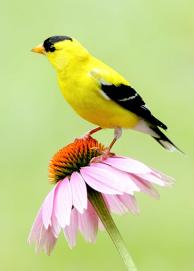
American Gold Finch
Read more about the American Goldfinch -
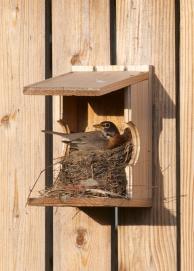
American Robin
Read more about the American Robin -
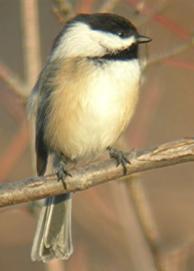
Black-Capped Chickadee
Read more about the Black-Capped Chickadee -
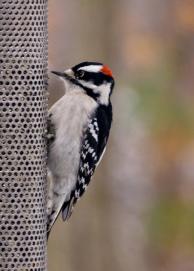
Downy Woodpecker
Read more about the Downy Woodpecker -
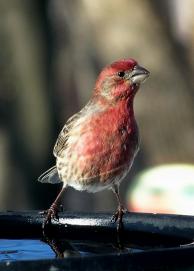
House Finch (Male)
Read more about House Finch -
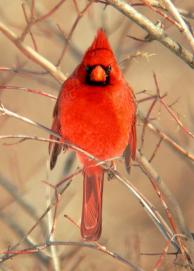
Northern Cardinal
Read More about Northern Cardinal
